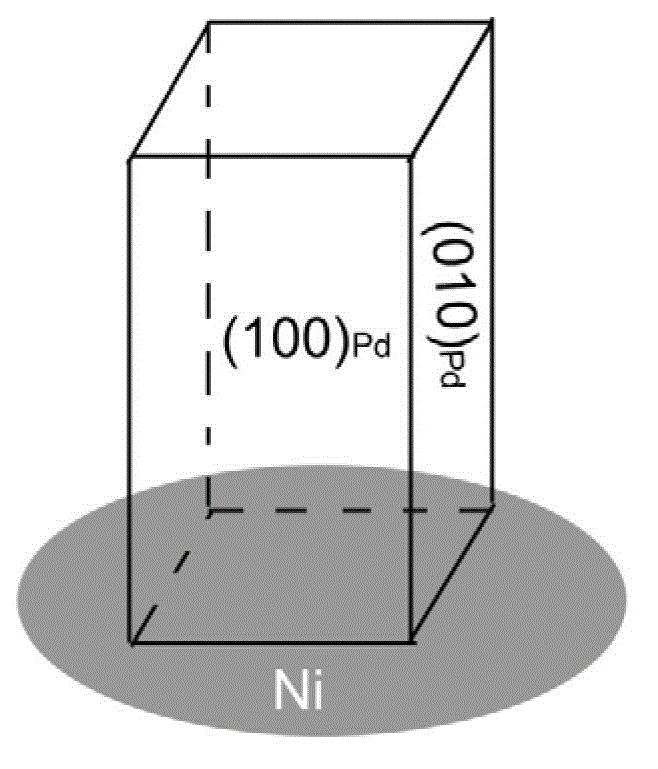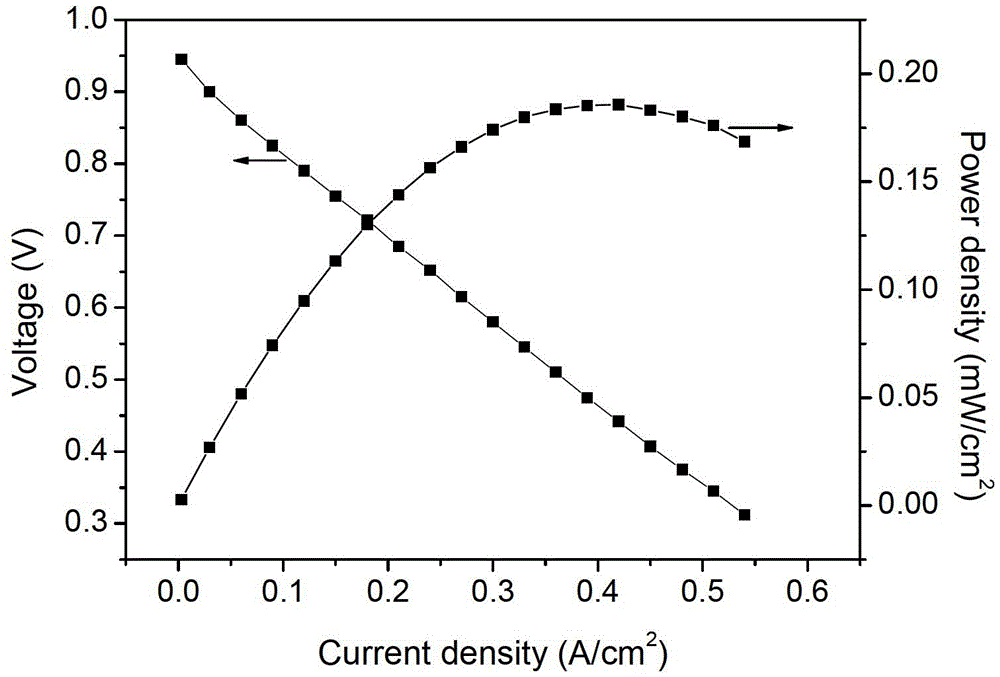Fuel cell anode and in situ preparation method thereof
A fuel cell and in-situ preparation technology, which is applied to battery electrodes, circuits, electrical components, etc., can solve the problems of unstable electron conduction, poor binding force, and low catalyst space utilization, and achieve large actual space utilization and high efficiency. The effect of conductivity and good service life
- Summary
- Abstract
- Description
- Claims
- Application Information
AI Technical Summary
Problems solved by technology
Method used
Image
Examples
Embodiment 1
[0028] A fuel cell anode uses foamed nickel as a current collector, Pd nano short rods are distributed on the surface of the foamed nickel, and the Pd nano short rods are used as an anode catalyst of the fuel cell. Pd nanorods do not overlap each other; Pd nanoparticles do not overlap each other, such as figure 1 shown. The number of short Pd nanorods is infinite.
[0029] An in-situ preparation method of a fuel cell anode, comprising the following steps:
[0030] 1) Install nickel foam as the carrier and collector of the anode catalyst on one side of the anode plate; assemble a direct sodium borohydride fuel cell with Pt / C catalyst as the cathode, and heat the battery to 80 o C;
[0031] 2) On the anode side, first pass a mixed solution composed of polyvinylpyrrolidone, sodium chloropalladate, potassium bromide and ethanol and keep the mixed solution in the anode flow field, and then slowly pass ascorbic acid into the anode flow field Solution or sodium borohydride soluti...
Embodiment 2
[0046] Using Pt / C as the cathode, N117 membrane as the electrolyte membrane, and nickel foam as the anode current collector and catalyst substrate, a direct sodium borohydride fuel cell was assembled. Warm up the battery to 80 o C and keep warm. Pass the mixture of polyvinylpyrrolidone, sodium chloropalladate, potassium bromide and ethanol from the anode side to the anode flow field inside the battery and keep it in the anode flow field, then slowly pass into the ascorbic acid solution, and keep the reaction for about 1 hour. Rinse the anode flow field with deionized water. The short rods of Pd nanometers grow on the surface of nickel foam to form a mace-like structure. The short Pd nanorods have a diameter of about 5 nm, a length of about 20 nm, an average spacing of 50 nm, and four sides are {100} Pd Planes. Afterwards, sodium borohydride alkaline fuel is fed into the anode, and oxygen is fed into the cathode. The battery discharge test results show that the battery has ...
Embodiment 3
[0048] With Co / N / C as the cathode, N117 membrane as the electrolyte membrane, and nickel foam as the anode current collector and catalyst substrate, a direct sodium borohydride fuel cell was assembled. Warm up the battery to 80 o C and keep warm. A mixture of polyvinylpyrrolidone, sodium chloropalladate, potassium bromide and ethanol is introduced from the anode side to the anode flow field inside the battery and kept in the anode flow field, and then a dilute sodium borohydride solution is slowly introduced to keep the reaction for about After 0.5 h, the anode flow field was washed with deionized water. The short rods of Pd nanometers grow on the surface of nickel foam to form a mace-like structure. The short Pd nanorods have a diameter of about 20 nm, a length of about 500 nm, an average spacing of 200 nm, and four sides are {100} Pd Planes. Afterwards, sodium borohydride alkaline fuel is fed into the anode, and oxygen is fed into the cathode. The battery discharge test ...
PUM
| Property | Measurement | Unit |
|---|---|---|
| Diameter | aaaaa | aaaaa |
| Length | aaaaa | aaaaa |
| Average spacing | aaaaa | aaaaa |
Abstract
Description
Claims
Application Information
 Login to View More
Login to View More - R&D
- Intellectual Property
- Life Sciences
- Materials
- Tech Scout
- Unparalleled Data Quality
- Higher Quality Content
- 60% Fewer Hallucinations
Browse by: Latest US Patents, China's latest patents, Technical Efficacy Thesaurus, Application Domain, Technology Topic, Popular Technical Reports.
© 2025 PatSnap. All rights reserved.Legal|Privacy policy|Modern Slavery Act Transparency Statement|Sitemap|About US| Contact US: help@patsnap.com



